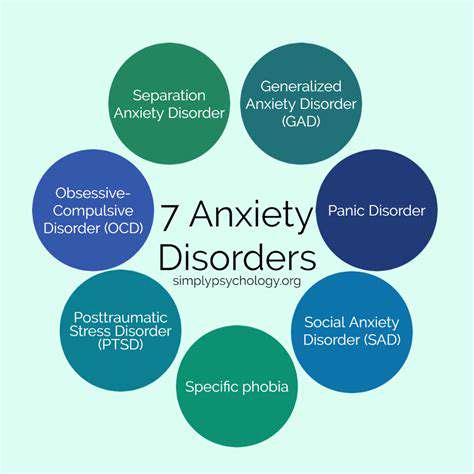Exploring Hyperreflexia and Its Connection to Anxiety
Hyperreflexia and Anxiety: A Connection?
While primarily a neurological symptom, emerging research explores potential links between anxiety and reflex abnormalities. The relationship remains incompletely understood, but theories suggest stress hormones or autonomic nervous system activity might influence reflex responses. This potential association warrants further scientific investigation to clarify any clinical significance.
Regardless of this possible connection, hyperreflexia always merits proper neurological evaluation to identify its underlying cause.
The Nervous System's Role in Anxiety and Reflexes

The Brain's Role in Anxiety
Brain function fundamentally influences anxiety as it processes emotions and threat perception. Key regions including the amygdala (fear processing), hippocampus (memory integration), and prefrontal cortex (emotional regulation) interact complexly to generate anxious responses. When these systems become dysregulated, normal threat assessment may malfunction, potentially contributing to anxiety disorders.
The hippocampus, crucial for contextualizing memories, often shows abnormalities in anxious individuals. This may impair their ability to appropriately moderate fear responses based on past experiences.
Neurotransmitters and Anxiety
Chemical messengers in the brain significantly impact anxiety levels. Serotonin (mood regulation), norepinephrine (alertness), and GABA (calming) represent particularly important neurotransmitters in anxiety disorders. Imbalances in these systems can lead to heightened anxiety states, with:- Low serotonin associated with increased anxiety- Excessive norepinephrine linked to panic symptoms- Reduced GABA activity potentially causing nervous system overexcitation
The Autonomic Nervous System
This involuntary control system regulates essential bodily functions. During anxiety episodes, its sympathetic division triggers fight-or-flight responses, increasing heart rate, blood pressure, and respiration. This physiological activation represents a hallmark feature of anxiety experiences.
The Impact of Stress on the Nervous System
Chronic stress produces lasting neurological changes that may predispose to anxiety disorders. Prolonged stress exposure can alter brain structure and function, particularly in regions involved in emotional regulation. These changes may increase vulnerability to anxiety and affect neurochemical balance.
The Role of Genetics and Environment
Anxiety development involves both inherited and experiential factors. While genetic predispositions may increase susceptibility, environmental stressors often trigger symptom onset. Early life experiences and significant stressors can interact with biological vulnerabilities to produce anxiety disorders.
Anxiety Disorders and Their Impact on Neurological Function

Understanding Anxiety Disorders
These mental health conditions involve excessive, persistent worry that impairs daily functioning. While anxiety serves as a normal protective mechanism, its pathological form causes significant distress and disability. Multiple factors contribute to development, including genetic vulnerabilities, neurochemical imbalances, and life experiences.
Types of Anxiety Disorders
Several distinct forms exist:- Generalized Anxiety Disorder: pervasive worry about multiple life aspects- Panic Disorder: recurrent, unexpected panic attacks- Social Anxiety Disorder: intense fear of social situations- Specific Phobias: irrational fears of particular objects/situations- Agoraphobia: fear of situations where escape seems difficult
Symptoms and Diagnosis
Anxiety disorders manifest through both psychological and physical symptoms including excessive worry, restlessness, concentration difficulties, sleep disturbances, and autonomic symptoms like palpitations. These symptoms often significantly impair work performance and relationships.
Diagnosis requires comprehensive evaluation by mental health professionals, incorporating symptom assessment, medical history, and functional impact analysis.
Impact on Daily Life
Anxiety disorders can profoundly affect multiple life domains:- Occupational functioning (reduced productivity, absenteeism)- Social interactions (avoidance, relationship strain)- Physical health (increased risk for various medical conditions)The cumulative effect often substantially diminishes quality of life.
Treatment and Management
Effective approaches typically combine:- Psychotherapy (especially Cognitive Behavioral Therapy)- Medication when appropriate (SSRIs, SNRIs, benzodiazepines)- Lifestyle modifications (exercise, stress management)Comprehensive treatment plans addressing biological, psychological, and social factors yield optimal outcomes.
Canine pregnancy typically spans about 63 days, though slight variations occur between breeds. Recognizing early signs like appetite changes and behavioral shifts facilitates proper prenatal care.
Hyperreflexia as a Potential Indicator of Underlying Anxiety
Understanding Hyperreflexia
This neurological sign involves excessive reflex responses to standard stimuli. While not diagnostic of any specific condition, it warrants investigation as it may indicate nervous system dysfunction. The reflex arc's complex physiology involves coordinated activity between sensory nerves, spinal cord, and motor pathways.
Potential Links to Anxiety
Though not a core anxiety symptom, some evidence suggests possible associations between anxiety states and reflex abnormalities. Current research examines whether anxiety-related neurological changes might subtly affect reflex responses. This remains an area requiring further scientific exploration.
Other Potential Causes of Hyperreflexia
Numerous neurological conditions beyond anxiety can produce hyperreflexia, including:- Spinal cord injuries- Multiple sclerosis- Cerebral palsy- StrokeProper diagnosis requires excluding these and other potential causes through comprehensive evaluation.
Importance of Differential Diagnosis
Accurate identification of hyperreflexia's cause proves essential for appropriate management. The diagnostic process should consider:- Complete medical history- Neurological examination findings- Potential need for ancillary testingThis systematic approach helps ensure correct diagnosis and treatment.
The Importance of Comprehensive Evaluation
Understanding Hyperreflexia
This neurological finding reflects excessive reflex responses and indicates potential central nervous system dysfunction. Its presence should prompt thorough evaluation to determine underlying causes and appropriate interventions.
The Neurological Basis of Reflexes
Reflexes represent automatic responses mediated by neural circuits involving sensory input, spinal cord processing, and motor output. Disruptions anywhere in these pathways may produce abnormal responses like hyperreflexia.
Clinical Manifestations of Hyperreflexia
Patients may display:- Exaggerated tendon reflexes- Increased muscle tone- Possible clonus (rhythmic oscillations)Documenting these findings aids diagnosis and treatment planning.
Differential Diagnosis and Associated Conditions
Hyperreflexia accompanies various neurological disorders including:- Upper motor neuron lesions- Multiple sclerosis- Spinal cord pathology- Certain stroke typesAccurate diagnosis guides appropriate management strategies.
Evaluation Techniques for Assessing Hyperreflexia
Standardized neurological examinations assess:- Reflex response intensity- Symmetry between sides- Presence of pathological reflexesConsistent methodology ensures reliable results.
The Role of Hyperreflexia in Diagnosing Neurological Disorders
When combined with other findings, hyperreflexia helps clinicians:- Localize neurological dysfunction- Determine potential causes- Guide further testingIts proper interpretation contributes significantly to neurological assessment.